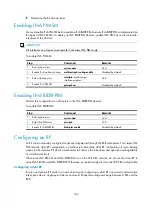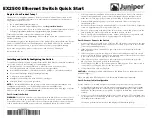
313
Task
Remarks
Enabling state-refresh capability
Optional.
Configuring state-refresh parameters
Optional.
Configuring IPv6 PIM-DM graft retry period
Optional.
Configuring common IPv6 PIM features
Optional.
Configuration prerequisites
Before you configure IPv6 PIM-DM, complete the following tasks:
•
Enable IPv6 forwarding and configure an IPv6 unicast routing protocol so that all devices in the
domain are interoperable at the network layer.
•
Determine the interval between state refresh messages.
•
Determine the minimum time to wait before receiving a new refresh message.
•
Determine the hop limit value of state-refresh messages.
•
Determine the graft retry period.
Enabling IPv6 PIM-DM
When IPv6 PIM-DM is enabled, a router sends hello messages periodically to discover IPv6 PIM
neighbors and processes messages from the IPv6 PIM neighbors. When you deploy an IPv6 PIM-DM
domain, enable IPv6 PIM-DM on all non-border interfaces of routers.
IPv6 PIM-DM does not work with IPv6 multicast groups in the IPv6 SSM group range.
IMPORTANT:
All the interfaces on a device must be enabled with the same IPv6 PIM mode.
To enable IPv6 PIM-DM:
Step
Command
Remarks
1.
Enter system view.
system-view
N/A
2.
Enable IPv6 multicast routing.
multicast ipv6 routing-enable
Disabled by default.
3.
Enter interface view.
interface
interface-type
interface-number
N/A
4.
Enable IPv6 PIM-DM.
pim ipv6 dm
Disabled by default.
Enabling state-refresh capability
Pruned interfaces resume multicast forwarding when the pruned state times out. To prevent this, the router
directly connected with the IPv6 multicast source periodically sends an (S, G) state-refresh message,
which is forwarded hop-by-hop along the initial flooding path of the IPv6 PIM-DM domain, to refresh the
prune timer state of all the routers on the path. A shared-media subnet can have the state-refresh
capability only if the state-refresh capability is enabled on all IPv6 PIM routers on the subnet.
To enable the state-refresh capability:
















































